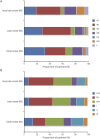Clinical and therapeutic features of myasthenia gravis in adults based on age at onset
- PMID: 32071167
- PMCID: PMC7220233
- DOI: 10.1212/WNL.0000000000008903
Clinical and therapeutic features of myasthenia gravis in adults based on age at onset
Abstract
Objective: To describe the characteristics of patients with very-late-onset myasthenia gravis (MG).
Methods: This observational cross-sectional multicenter study was based on information in the neurologist-driven Spanish Registry of Neuromuscular Diseases (NMD-ES). All patients were >18 years of age at onset of MG and onset occurred between 2000 and 2016 in all cases. Patients were classified into 3 age subgroups: early-onset MG (age at onset <50 years), late-onset MG (onset ≥50 and <65 years), and very-late-onset MG (onset ≥65 years). Demographic, immunologic, clinical, and therapeutic data were reviewed.
Results: A total of 939 patients from 15 hospitals were included: 288 (30.7%) had early-onset MG, 227 (24.2%) late-onset MG, and 424 (45.2%) very-late-onset MG. The mean follow-up was 9.1 years (SD 4.3). Patients with late onset and very late onset were more frequently men (p < 0.0001). Compared to the early-onset and late-onset groups, in the very-late-onset group, the presence of anti-acetylcholine receptor (anti-AChR) antibodies (p < 0.0001) was higher and fewer patients had thymoma (p < 0.0001). Late-onset MG and very-late-onset MG groups more frequently had ocular MG, both at onset (<0.0001) and at maximal worsening (p = 0.001). Although the very-late-onset group presented more life-threatening events (Myasthenia Gravis Foundation of America IVB and V) at onset (p = 0.002), they required fewer drugs (p < 0.0001) and were less frequently drug-refractory (p < 0.0001).
Conclusions: Patients with MG are primarily ≥65 years of age with anti-AChR antibodies and no thymoma. Although patients with very-late-onset MG may present life-threatening events at onset, they achieve a good outcome with fewer immunosuppressants when diagnosed and treated properly.
© 2020 American Academy of Neurology.
Figures



Comment in
-
New insights into very-late-onset myasthenia gravis.Nat Rev Neurol. 2020 Jun;16(6):299-300. doi: 10.1038/s41582-020-0345-3. Nat Rev Neurol. 2020. PMID: 32203394 No abstract available.
References
-
- Gilhus NE. Myasthenia gravis. N Engl J Med 2016;375:2570–2581. - PubMed
-
- Querol L, Illa I. Myasthenia gravis and the neuromuscular junction. Curr Opin Neurol 2013;26:459–465. - PubMed
-
- Gilhus NE, Verschuuren JJ. Myasthenia gravis: subgroup classification and therapeutic strategies. Lancet Neurol 2015;14:1023–1036. - PubMed
-
- Patrick J, Lindstrom J. Autoimmune response to acetylcholine receptor. Science 1973;180:871–872. - PubMed
